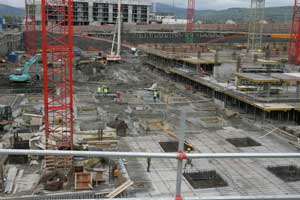13 October 2005 Edition
Clock ticking on Irish economy

Despite the booming Irish economy, figures show increased inequality
Irish economy: Figures show increased inequality
BY
ROBBIE SMYTH
New figures released by the Economic and Social Research Institute (ESRI), the Central Statistics Office and the Department of Finance measuring the performance of the 26-County economy all point to coming years of sustained economic growth. However, there are clouds on the horizon that could threaten employment levels and highlight the gulf between those who have wealth in Ireland and those who don't. In prevailing circumstances those who don't will remain at best on low incomes, at risk of falling into poverty and at worst enduring serious deprivation.
Extra billion euro
The Department of Finance has released exchequer returns for the fist nine months of 2005. The good news was that the government already have a billion euro more collected in 2005 than forecast.
Tax Revenue at the end of September stood at €26.4 billion, up €1 billion on the previous 12 months. In all tax receipts are up 7.5% in the year to date, but where is the increase coming from?
€351 million of the extra billion comes from VAT receipts, the taxes we pay for buying the everyday goods and services we need for daily life. Another €348 million came from stamp duty, mostly from house purchases. A major part of the Remaining €300 million comes from back taxes paid by those caught in the Revenue Commissioners special investigations into illegal offshore bank accounts and other forms of tax evasion.
The lowest contributions to the growth in tax revenue comes from income tax while corporation tax on business profits is over €500 million down for the year. For an economy that added 95,000 new jobs in the last year it doesn't add up that there is a decrease in business tax revenue. In terms of the failure to generate a big rise in income tax it must mean that the new jobs created were so low paid that the new workers are not in the tax net.
Unemployment threat
The nature of employment growth was touched on in the latest quarterly review published by the ESRI last week. It predicted that the economy would grow by 5.7% in 2005. The CSO forecast is for a 5.1% growth rate.
The ESRI believes the higher growth is driven by increased worker productivity. They caution though that there are pressures in the jobs market. In particular they point to ongoing job losses in the agricultural and manufacturing sectors being soaked up by growth in the construction sector which could lead to more job losses if the construction which has been in overdrive begins to slow.
These low-skilled workers will not be able to find new employment and we could have high unemployment among low-paid workers. These do not have savings, private health insurance, or pensions and are at the bottom of the property ladder. Loss of income even for a short period could prove disastrous.
The economy in figures
€26,863 million - tax receipts for the first nine months of 2005
€25,191 million - tax receipts for the first nine months of 2004
7.5% increase in tax revenue so far this year
€351 million - VAT increase in 2005
€348 million - Stamp Duty increase in 2005
€48 million - Income Tax increase in 2005, including receipts from Revenue's special €300 million - Receipts from Revenue Commissioners special investigations
€181 million - Increase in Excise duties
€281 million - drop in Corporation tax so far in 2005
93,000 - ESRI estimate of new jobs in the Irish economy over the last 12 months
5.7% - the rate of economic growth forecast for 2005
1,945,000 - ESRI estimate of the numbers at work in 2005


